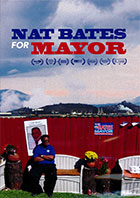
Nat Bates for Mayor 2017
Distributed by The Video Project, 145 - 9th St., Suite 102, San Francisco, CA 94103; 800-475-2638
Produced by Bradley Berman and Eric Weiss
Directed by Eric Weiss and Bradley Berman
DVD, color, 75 or 57 min.
College - General Adult
Politics, Government, African Americans
Date Entered: 01/04/2018
Reviewed by Brian Falato, University of South Florida Tampa Campus LibraryRichmond, California is a city of 107,000 five miles north of Berkeley and across San Pablo Bay from San Francisco. Its population grew exponentially during World War II when the Richmond shipyards drew thousands of workers from other parts of the country. It is home to a 29,000 acre Chevron refinery, built in 1902 and the second largest in the state.
The 2014 mayoral election in Richmond is the focus of Nat Bates for Mayor. The incumbent mayor, who had opposed many of Chevron’s actions and led a lawsuit against the company over a massive refinery fire, was term-limited and not able to run again. The main candidates in the race were Bates, an African American who had served on the City Council for 35 years, and Tom Butt, a white architect who was on the Council for 19 years. Bates had support from Chevron and much of the African American community, while Butt’s main support was from the Richmond Progressive Alliance, a Chevron opponent, and the mostly white residents of the wealthier Port Richmond enclave.
The documentary shows how much race was a factor in the election. The shipyards had drawn many African Americans to Richmond during the World War II, and they constituted 35% of the population at one time. But the power blacks enjoyed in the city was waning, and the African American population was now down to 25%. At a Bates rally, a former San Francisco resident said the African American population in that city was now only 3% because of the enormous cost of living there. She said she didn’t want to see this happen in Richmond, but feared that it could.
And Butt was part of a nascent gentrification process. He bought a derelict hotel in Port Richmond and renovated it. This led to further investment and increased property values in the area so much that Port Richmond now had the highest real estate values in the city. While the Richmond Progressive Alliance saw itself as defending Richmond residents against pollution and corporate dominance by Chevron, Bates and his supporters saw the group as endangering the well-paying Chevron jobs that allowed the working class a measure of prosperity. The RPA was viewed as a bunch of paternalistic white people who thought they knew what was best for blacks. Bates said their name should be the Richmond Plantation Alliance.
Giving a viewer something to think about on both sides, the documentary builds some suspense as the election outcome is awaited. The results seem to be a triumphant victory for one side, but it would be interesting to revisit the city in five years to see how much has changed.
The DVD contains both the full 75-minute version, and the condensed 57 minute version that has open captioning.
This documentary is especially recommended for college classes in African American studies and political science, but it is worthwhile for general audiences as well. The issues raised are faced in many other places in the country besides Richmond.